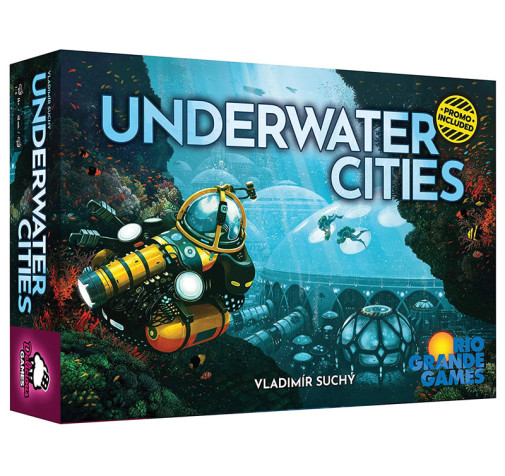We use cookies to make your experience better. To comply with the new e-Privacy directive, we need to ask for your consent to set the cookies. Learn more.
Underwater Cities Game
As inhabitants of earth, humankind has always made their home on the 29% of Earth's area known as “land". Earth is covered by 71% water and when the population can no longer be sustained on land, can humankind survive and thrive by establishing colonies and cities underwater?
This game brings the challenge of building habitable cities under the sea. This provides players with a beautiful, complex and challenging game experience. The greatest intellectual resources recruited for this task are the players who compete to build the most successful underwater nation.
Each player starts with his or her own city location board and one city. Throughout the game, cards and resources are acquired to build this new metropolis using city domes, tunnels to connect them, kelp farms to produce food, desalinization plants to provide fresh water and laboratories where technology is explored that will help with planning and implementation. In order for the population of each city to benefit from these resources and score points for their structures, all cities are required to connect with their first “home" city.
Underwater Cities takes place across three eras, during ten player rounds of three turns each. During each round, all players take turns placing their three player action tiles on the main board to gain resources, cards, card actions and other benefits. At the end of each round, the turn order markers reset, the round/era counter is advanced and all players collect their action tiles. Once an Era has ended, a production phase ensues which gives players the opportunity to earn points for their city and structure progress as well as points awarded from cards collected in a player's tableau that furnish benefits and victory points during the production phase.
The engine that drives this game is the cards. Together, the cards create a multi-layered, integrated collection that players use with specific mainboard locations and card plays. As players draw a new card at the end of each turn, there is time to contemplate how to use the right card on their next turn as they strategize both immediate and long-term goals. There are Orange, Red and Green action zones on the mainboard that when matched with the color of the card that is played, gives the player an additional action during each of their turns. Some cards give players an immediate benefit; others give benefits throughout the game, during the production phase or at the end of the game. In addition, there is a mainboard action space that allows a player to acquire special cards that may furnish actions and resources or game-end goals that earn additional points.
Because points are awarded during three separate production phases at the end of each era as well as at game end, and also due to the variety of ways in which points are earned during the game, it is wonderful to not be entirely sure who might win the game until the end. This makes it more fun to continue strategizing throughout the entirety of this experience. There is a 30 to 45-minute game time per player, with a range of 1-4 player count. The player with the most points at the end of the game wins! After playing Underwater Cities several times, I find it to be a satisfying, strategic experience, which smoothly brings various game mechanics and tools together in such a rewarding way that once it is on my table, it is compelling to keep replaying! Although it is officially recommended for ages 14+, the game-playing community's informed opinion is that many 12-year-old persons have successfully enjoyed playing. ~Marsha
Underwater Cities is a game for 1-4 players and takes about 30-45 minutes per player. The players represent the most powerful brains in the world, brains nominated due to the overpopulation of Earth to establish the best and most livable underwater areas possible.
As overcrowded metropolises spread across the earth, humanity has realized it is time to establish a new home on the ocean floor. Kelp farms can provide food. Desalination plants can provide water. And laboratories can provide the technology needed to build a network of underwater cities.
Please also see our Logic - Games section for more excellent strategy games.
| Product Format: | Other |
|---|---|
| Brand: | Rio Grande Games |
| Grades: | 9-AD |
| EAN/UPC: | 655132005647 |
| Length in Inches: | 9.125 |
| Width in Inches: | 12.625 |
| Height in Inches: | 2.875 |
| Weight in Pounds: | 4.1 |

